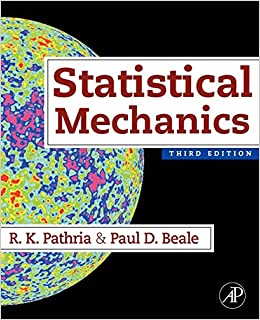We shall consider only the Heisenberg model; the study of the Ising model is somewhat simpler. Following
Question:
We shall consider only the Heisenberg model; the study of the Ising model is somewhat simpler. Following the procedure of Problem 12.7, we find that the "effective field" \(\mathbf{H}_{a}\) experienced by any given spin \(\mathbf{s}\) on the sublattice \(a\) would be
\[
\begin{equation*}
\mathbf{H}_{a}=\mathbf{H}-\frac{2 q^{\prime} J^{\prime}}{g \mu_{B}} \overline{\mathbf{s}}_{b}-\frac{2 q J}{g \mu_{B}} \overline{\mathbf{s}}_{a} \tag{1a}
\end{equation*}
\]
where \(q^{\prime}\) and \(q\) are, respectively, the number of nearest neighbors on the other and on the same sub-lattice, while \(J^{\prime}\) and \(J\) are the magnitudes of the corresponding interaction energies. Similarly,
\[
\begin{equation*}
\mathbf{H}_{b}=\mathbf{H}-\frac{2 q^{\prime} J^{\prime}}{g \mu_{B}} \overline{\mathbf{s}}_{a}-\frac{2 q J}{g \mu_{B}} \overline{\mathbf{s}}_{b} \tag{1b}
\end{equation*}
\]
The net magnetization, per unit volume, of the sub-lattices \(a\) and \(b\) at high temperatures is then given by, see eqns. (2) and (3) of the preceding problem,
\[
\begin{aligned}
& \mathbf{M}_{a} \equiv \frac{1}{2} n\left(g \mu_{B} \overline{\mathbf{s}}_{a}\right) \approx \frac{1}{2} n \cdot \frac{g^{2} \mu_{B}^{2} s(s+1)}{3 k T}\left\{\mathbf{H}-\frac{4 q^{\prime} J^{\prime}}{n g^{2} \mu_{B}^{2}} \mathbf{M}_{b}-\frac{4 q J}{n g^{2} \mu_{B}^{2}} \mathbf{M}_{a}\right\}, \\
& \mathbf{M}_{b} \equiv \frac{1}{2} n\left(g \mu_{B} \overline{\mathbf{s}}_{b}\right) \approx \frac{1}{2} n \cdot \frac{g^{2} \mu_{B}^{2} s(s+1)}{3 k T}\left\{\mathbf{H}-\frac{4 q^{\prime} J^{\prime}}{n g^{2} \mu_{B}^{2}} \mathbf{M}_{a}-\frac{4 q J}{n g^{2} \mu_{B}^{2}} \mathbf{M}_{b}\right\} .
\end{aligned}
\]
Adding these two results, we obtain for the total magnetization of the lattice
\[
\begin{equation*}
\mathbf{M} \approx \frac{C}{T}\left\{\mathbf{H}-\left(\gamma^{\prime}+\gamma\right) \mathbf{M}\right\} \quad\left[\gamma^{\prime}=\frac{2 q^{\prime} J^{\prime}}{n g^{2} \mu_{B}^{2}}, \gamma=\frac{2 q J}{n g^{2} \mu_{B}^{2}}\right] \tag{2}
\end{equation*}
\]
the parameter \(C\) here is the same as defined in eqn. (5) of the preceding problem. Equation (2) may be written in the form
\[
\begin{equation*}
\mathbf{M} \approx \frac{C}{T+\theta} \mathbf{H}, \text { where } \theta=\left(\gamma^{\prime}+\gamma\right) C \tag{3}
\end{equation*}
\]
this yields the desired result for the paramagnetic susceptibility of the lattice. Note that the parameter \(\theta\) here has no direct bearing on the onset of a phase transition in the system; for that, we must examine the possibility of spontaneous magnetization in the two sub-lattices.
To study the possibility of spontaneous magnetization, we let \(\mathbf{H} \rightarrow 0\); in that limit, the vectors \(\mathbf{M}_{a}\) and \(\mathbf{M}_{b}\) are equal in magnitude but opposite in direction. We may then write: \(\mathbf{M}_{a}=\mathbf{M}^{*}, \mathbf{M}_{b}=-\mathbf{M}^{*}\), and study only the former. In analogy with eqn. (6) of the preceding problem, we now have
\[
\begin{equation*}
M^{*}=\frac{1}{2} n\left(g \mu_{B} s\right) B_{s}\left(x_{0}\right) \quad\left[x_{0}=\frac{4 s\left(q^{\prime} J^{\prime}-q J\right) M^{*}}{n g \mu_{B} k T}\right] . \tag{4}
\end{equation*}
\]
We now employ expansion (7) of the preceding problem and get
\[
\begin{equation*}
M^{*}=\frac{T_{N}}{T} M^{*}-\frac{b}{\left(\frac{1}{2} n g \mu_{B} s \right)^{2}}\left(\frac{T_{N}}{T} M^{*}\right)^{3}+\ldots \tag{5}
\end{equation*}
\]
where
\[
\begin{equation*}
T_{N}=\frac{2 s(s+1)}{3 k}\left(q^{\prime} J^{\prime}-q Jght), \tag{6}
\end{equation*}
\]
while the number \(b\) is the same as given by eqn. (9) of the preceding problem. Clearly, for \(T
Step by Step Answer:






